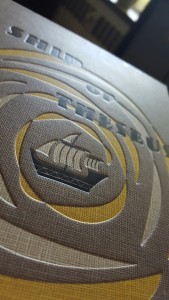S. describes in great detail the ship he finds himself on. “He recognizes it as a xebec design,” which was a type of ship used mainly in the Mediterranean and typically associated with “the pirates of previous centuries.” It is noted that the ship is some state of disrepair with parts of it falling apart and other’s patched together. S. recognizes various elements of the ship such as “the three lateen sails” and the “mizzenmast” which leads him to realize that despite his amnesia “he is someone who knows at least a few things about ships.”
In the margins Jen and Eric comment on the ship and its relevance to the title of the book. With its constant mismatched renovations, the ship is “turning into another ship entirely” which is what happens to The Ship of Theseus in Greek Mythology. This is also connected to Theseus’ Paradox which brings into question whether the vessel that S. finds himself on at the beginning of the novel is in fact the same ship that he travels on at the end of the book.
In Greek Mythology Ariadne is Theseus’ lover and Eric draws a connection between a ship named the Ariadne in a different Straka book called Miracle in Braxenholm and the ship that S. finds himself on. This implies that there is a relationship between the two novels.
Eric equates the “19 sailors” to the “19 books” that VMS has written. S. describes the crew as being “drawn from all corners of the globe” which could be a statement about the various Straka novels. They are potentially a mismatched collaboration of several authors under one pseudonym.


You must be logged in to post a comment.